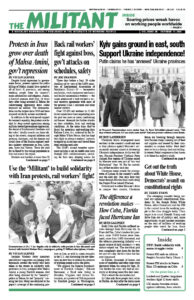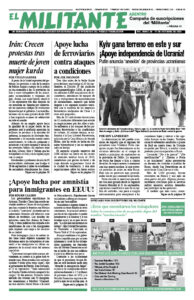Both Cuba and Florida suffered serious damage from Hurricane Ian. In Pinar del Río, Cuba’s hardest hit province, some 53,000 homes were damaged, more than 5,000 destroyed, and the tobacco processing industry — a major source of hard currency — was almost wiped out. The electrical grid was completely shut down for the better part of a day, the first time that has ever happened.
In Florida, thousands of homes and acres of vegetables and other crops were destroyed when the storm hit Sept. 28. The hardest hit areas still had no electricity or drinking water five days later.
That’s where the similarities end.
In Cuba only three people died, while in Florida, six days after the storm made landfall near Fort Meyers, more than 90 were confirmed dead. With hundreds of homes washed into the sea, entire mobile home parks wiped out, and farmworkers trapped on flooded farms, the real number of deaths will never be known.
This is not the result of a huge disparity in the destructiveness of the storm. It’s because in the U.S. working people are largely left on their own before, during and after a storm. In Cuba, the government mobilizes and leads working people to be prepared in advance, to make sure no one is left on their own, despite hardships and scarcities caused by Washington’s brutal 60-year economic war against the Cuban people and their revolution.
Florida Gov. Ron DeSantis issued a “mandatory” evacuation order, but offered no government help for workers to do so. In the absence of serious government action, working people there stepped forward themselves to save others during the storm.
Rafael Baca, who lives in Tampa’s Palmetto Beach, was one of those who stayed. “We don’t have the money for it now, to just leave,” he told the Washington Post. Baca was lucky. Tampa missed the brunt of the storm, which struck further south, including Lee County.
Many who tried to evacuate were caught in bumper-to-bumper traffic. For workers without a car, DeSantis announced people could get a $30-off voucher if they called Uber for a ride to a shelter.
As the storm neared, the governor changed course. He told people it was no longer safe to evacuate and they should “hunker down” wherever they were.
They didn’t get much help after the storm either. “Our cars are ruined. We haven’t had any water or food delivered to the area,” Craig Ruke in Fort Meyers Beach told the Miami Herald Oct. 2. “Everyone on this island is cut off.”
“As of this morning, nobody has brought in supplies besides the people trying to get to the island themselves to check on loved ones or if they still have a home,” Denise Martinez on Pine Island posted on Facebook. “All of the people on the island need food, water, gas, propane, they do not even have a roll of toilet paper.”
Thousands are now homeless and, because of prohibitive cost, less than 20% of homes in the hard-hit areas had flood insurance.
Cuba: No one left on their own
Despite the U.S. economic war against Cuba, the government ensures no one is left on their own. That’s because working people led by Fidel Castro ousted the U.S.-backed Batista dictatorship in 1959, bringing to power a government of workers and farmers, and opening the road to a socialist revolution.
The Civil Defense Committee — which is organized by the government and works with the neighborhood Committees for the Defense of the Revolution, the Federation of Cuban Women and other mass organizations — organizes practice sessions so that people across the island know what to do and where to go when a storm is on its way.
Nearly 40,000 people in Pinar del Río alone were evacuated from their homes. Similar evacuations took place from high risk areas across the country.
Up to the last minute, workers and volunteers across the country were cleaning drainage ditches and gratings, removing gasoline pumps from gas stations and doing what they could to protect critical infrastructure.
Medical personnel along with food and medical supplies were sent to more isolated areas ahead of time to make sure they had the resources needed.
Even so, given their resources and the U.S.-rulers’ embargo, the storm shut down the island’s entire electrical system. Without electricity, food spoiled in a country already facing shortages.
Over the last two decades, the revolutionary government and electrical workers have worked to build safeguards into the grid, which was designed in the 1960s with antiquated technology from the Soviet Union. That interlinked system was very vulnerable if even one major unit went down.
Today there are some 20 interconnected electrical subsystems — more than twice what existed up until 2005 — that made it possible to restore power step by step in the eastern, central and western regions and then relink most of the system. In Pinar del Río, where the damage was the most severe, it will take longer.
After several days of power outages some young people in Havana and other parts of the country staged protests demanding speedier restoration of power.
“Protesting is a right,” Luis Antonio Torres Iríbar, president of the Provincial Defense Council in Havana and head of the Communist Party there, said on TV Sept. 30. He noted that Cuban leaders went to the protests to discuss and explain what was being done.
Cuban President Miguel Díaz-Canel was on the scene in the hardest hit provinces soon after the storm was over. “We have to resolve this ourselves, with our own efforts, our own talent,” he said in an Oct. 2 statement from Pinar del Río. Members of the Federation of Cuban Women are going door to door to organize everyone into the effort.
An Oct. 1 article in the daily Granma noted that repairing the damage from Ian is a challenge. It comes on top of an Aug. 5 fire that destroyed half of the oil storage tanks at Cuba’s largest distribution facility in Matanzas.
The article reported workers stepped forward, including “those who have turned their homes into a recharging center for cellphones, those who share their stored water with their neighbors, those who cook for the family on their block who doesn’t have gas, those who after protesting, joined shoulder to shoulder with the president of the Municipal Defense Council to clear the streets of trees and debris.”
“When to some it seems there is no way out,” the paper editorialized Oct. 1, “Cuba has always found it with united work, solidarity and the participation of its own people.”
Unlike Florida, where most government “aid” will be channeled through capitalist contractors who will enrich themselves, in Cuba volunteer brigades of workers and youth from across the island are already joining together to clean up, replant crops and to rebuild homes.
That’s the difference a revolution makes.

